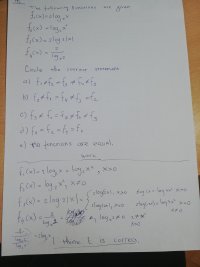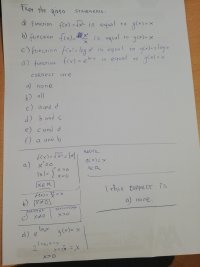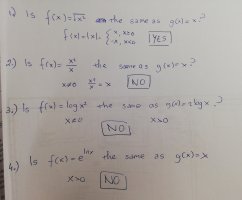You are using an out of date browser. It may not display this or other websites correctly.
You should upgrade or use an alternative browser.
You should upgrade or use an alternative browser.
Why isn't this correct?
- Thread starter Loki123
- Start date
Just a function.What is g(x) ?
Like f(x) it just uses gJust a function.
D
Deleted member 4993
Guest
What are your reasons for choosing those responses?The question says to see which of the following are correct and then to circle the answer which matches yours. I got that only 1 is right, but none of the answers match it.
A) 3 and 4
B) 3 and 2
C) 4 and 1
D) 1 and 2
E) all
F) none
View attachment 32466
You mean my response 1? Well as you can see I tried to solve it and got that.What are your reasons for choosing those responses?
Dr.Peterson
Elite Member
- Joined
- Nov 12, 2017
- Messages
- 16,088
But you showed that f(x) is equal to |x|, not to x; so f and g are not the same function!You mean my response 1? Well as you can see I tried to solve it and got that.
You have cryptically stated that the domains of f and g are different for 2, 3, and 4, so they are not equal. (It would be a lot clearer what you are thinking if you used words!)
So, what is the correct answer?
But isn't the domain of |x| the same as it is for x.But you showed that f(x) is equal to |x|, not to x; so f and g are not the same function!
You have cryptically stated that the domains of f and g are different for 2, 3, and 4, so they are not equal. (It would be a lot clearer what you are thinking if you used words!)
So, what is the correct answer?
blamocur
Elite Member
- Joined
- Oct 30, 2021
- Messages
- 2,627
Having the same domain does not mean that the functions are equal.But isn't the domain of |x| the same as it is for x.
You have been told repeatedly to quote the problem fully and exactly and not to use some paraphrase. Are the restrictions on the domain given in the problem, and if so do those restrictions apply just to f or to f and g? In any case is the question phrased positively or negatively, is it asking you to choose the correct option for the cases where f and g are equal or for the cases where f and g are not equal?
What is so hard about understanding that we cannot possibly help you answer a question correctly if you provide a garbled version of the question?
What is so hard about understanding that we cannot possibly help you answer a question correctly if you provide a garbled version of the question?
Determine which od the following are correct and then circle the answer that matches yours. This is the exact text I have been provided with.which of the following are correct and then to circle the answer which matches yours
It's not so much that I don't write correctly as it is that the questions I have been provided suck. They have no solutions. I don't know the answer and they are hand written without literature SO I have no way of checking them.
It is asking to see where do functions f and g have the same domain. Then circle the answer that matches which answers you got as correct.You have been told repeatedly to quote the problem fully and exactly and not to use some paraphrase. Are the restrictions on the domain given in the problem, and if so do those restrictions apply just to f or to f and g? In any case is the question phrased positively or negatively, is it asking you to choose the correct option for the cases where f and g are equal or for the cases where f and g are not equal?
What is so hard about understanding that we cannot possibly help you answer a question correctly if you provide a garbled version of the question?
Dr.Peterson
Elite Member
- Joined
- Nov 12, 2017
- Messages
- 16,088
No, the exact text includes what the functions are! We want to be sure exactly which parts that you show are the original problem, and which you have added. So you should first state the entire problem, and THEN show your work. Interleaving them makes the problem ambiguous.Determine which [of] the following are correct and then circle the answer that matches yours. This is the exact text I have been provided with.
My assumption is that you were given just the first line for each function, and the rest is yours.
Wait, wait! You didn't say it's asking about their domains; as you stated the problem before, it is asking whether the functions are the same -- the same function, not the same domain. These can't both be what it is asking.It is asking to see where do functions f and g have the same domain. Then circle the answer that matches which answers you got as correct.
Now we really, really need to see the entire problem exactly as written. If you just have it hand-written (I still have no idea why that is), show us an image of that original copy!
I have posted a similar problems with the same text where I was advised to find the domain. I will show you that problem along with the og copy of this one as soon as I am able to. Hopefully in a few hours.No, the exact text includes what the functions are! We want to be sure exactly which parts that you show are the original problem, and which you have added. So you should first state the entire problem, and THEN show your work. Interleaving them makes the problem ambiguous.
My assumption is that you were given just the first line for each function, and the rest is yours.
Wait, wait! You didn't say it's asking about their domains; as you stated the problem before, it is asking whether the functions are the same -- the same function, not the same domain. These can't both be what it is asking.
Now we really, really need to see the entire problem exactly as written. If you just have it hand-written (I still have no idea why that is), show us an image of that original copy!
Technically, the definition of a function should include its domain. It is true that frequently the domain is implied, particularly if the domain is all real numbers.
If two functions have different domains, they are not identical functions; they are not “the same.” That is true even if the functions are everywhere equal over their shared domains. Interpreting this question depends on what (if anything) the problem specifies as the domains for both f and g
It is of course possible that the question is badly worded. But I notice that nothing in the question as stated in post 1 mentions the word “domain“ nor asks whether the domains are the same. In post 12, you tell us that the question only asks whether the domains are the same. I have no idea what the actual problem is because you have given us two different versions.
We may have asked you to determine the implied domains to answer some third question.
Look at your post 1 and the fourth example. Perhaps what is meant is
[math]\text {If } x > 0, \ f(x) = e^{ln(x)}, \text { and } g(x) = x, \\ \text { is it true that } f(x) = g(x)?[/math]
If that is what is meant, then your answer of “no” is wrong.
If two functions have different domains, they are not identical functions; they are not “the same.” That is true even if the functions are everywhere equal over their shared domains. Interpreting this question depends on what (if anything) the problem specifies as the domains for both f and g
It is of course possible that the question is badly worded. But I notice that nothing in the question as stated in post 1 mentions the word “domain“ nor asks whether the domains are the same. In post 12, you tell us that the question only asks whether the domains are the same. I have no idea what the actual problem is because you have given us two different versions.
We may have asked you to determine the implied domains to answer some third question.
Look at your post 1 and the fourth example. Perhaps what is meant is
[math]\text {If } x > 0, \ f(x) = e^{ln(x)}, \text { and } g(x) = x, \\ \text { is it true that } f(x) = g(x)?[/math]
If that is what is meant, then your answer of “no” is wrong.
Dr.Peterson
Elite Member
- Joined
- Nov 12, 2017
- Messages
- 16,088
Finding the [implied or explicit] domain is part of what you need to do, but not all of it. See #9. Two functions are the same if they have the same domain, and the same values everywhere in the domain.I have posted a similar problems with the same text where I was advised to find the domain. I will show you that problem along with the og copy of this one as soon as I am able to. Hopefully in a few hours.
Here is everything written well, including an extra problem similar to the one at the top of this thread. Did I do them correctly now?Finding the [implied or explicit] domain is part of what you need to do, but not all of it. See #9. Two functions are the same if they have the same domain, and the same values everywhere in the domain.


I do not like the question because domains are not explicitly specified, and the problem requires careful thinking about domains. Furthermore, to say two functions are equal, they must have the same domains and must give identical values
for identical arguments.
With respect to a, the implied domain of f(x) is all real numbers, which is the SAME as the implied domain of g(x), but f(-4) = 4 whereas g(-4) = - 4. Not equal. But your work does not explicitly explain why they are unequal.
With regard to b, c, and d, you have explicitly shown that the functions have different domains.
I agree with your answer that none of the cases shows f(x) = g(x). But I do not understand how you got there.
for identical arguments.
With respect to a, the implied domain of f(x) is all real numbers, which is the SAME as the implied domain of g(x), but f(-4) = 4 whereas g(-4) = - 4. Not equal. But your work does not explicitly explain why they are unequal.
With regard to b, c, and d, you have explicitly shown that the functions have different domains.
I agree with your answer that none of the cases shows f(x) = g(x). But I do not understand how you got there.
A
Are we talking picture 1 or 2?I do not like the question because domains are not explicitly specified, and the problem requires careful thinking about domains. Furthermore, to say two functions are equal, they must have the same domains and must give identical values
for identical arguments.
With respect to a, the implied domain of f(x) is all real numbers, which is the SAME as the implied domain of g(x), but f(-4) = 4 whereas g(-4) = - 4. Not equal. But your work does not explicitly explain why they are unequal.
With regard to b, c, and d, you have explicitly shown that the functions have different domains.
I agree with your answer that none of the cases shows f(x) = g(x). But I do not understand how you got there.

